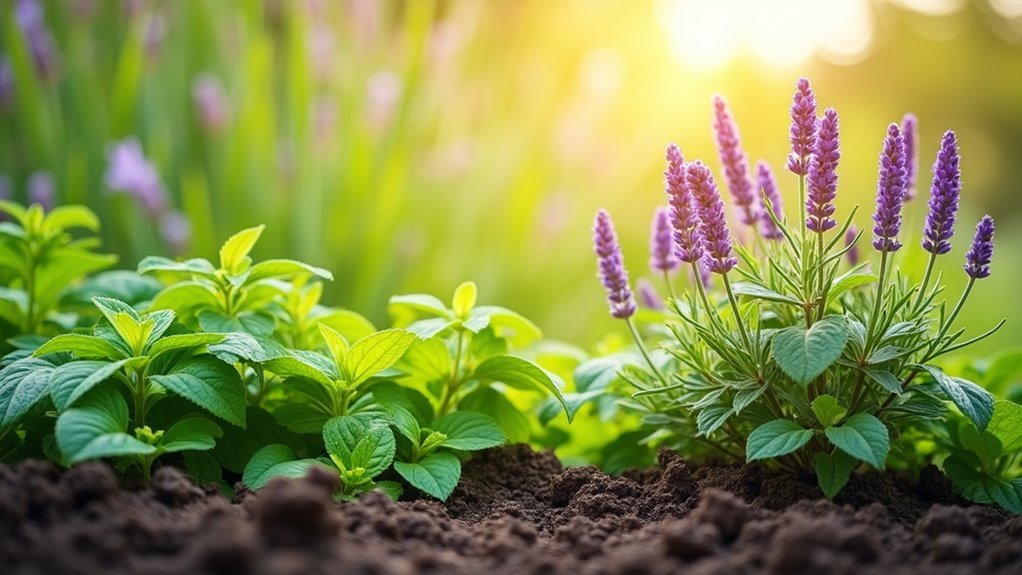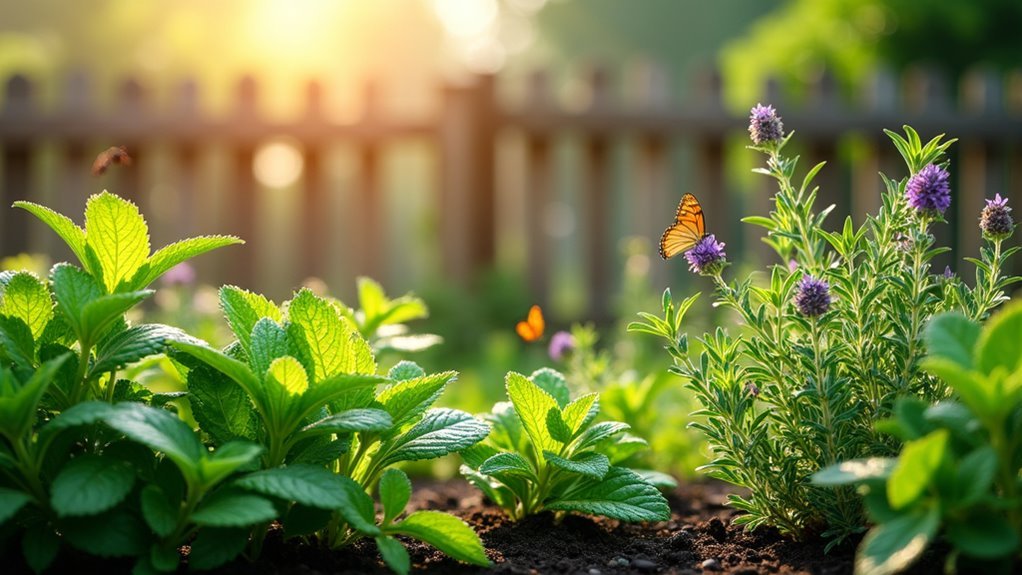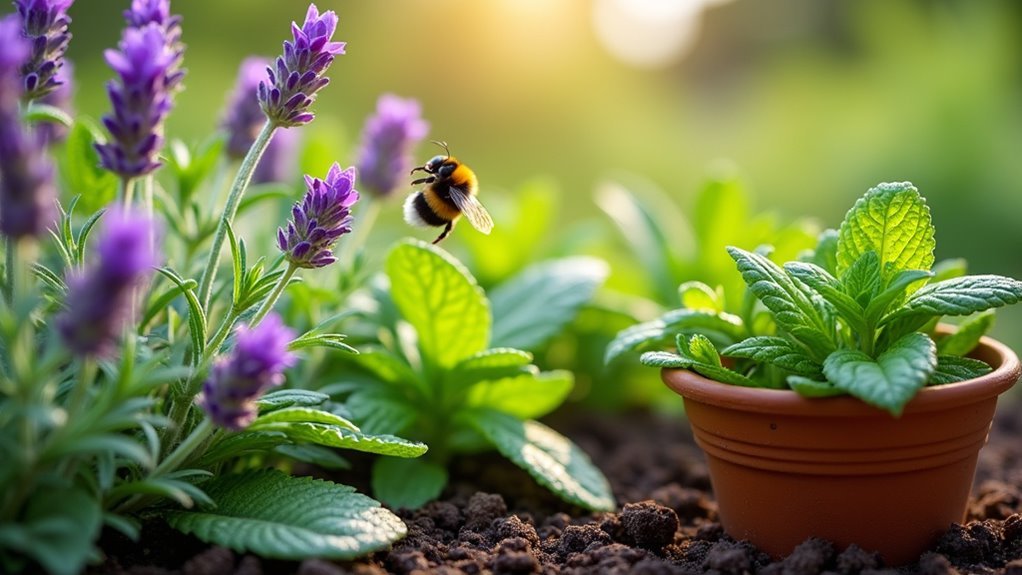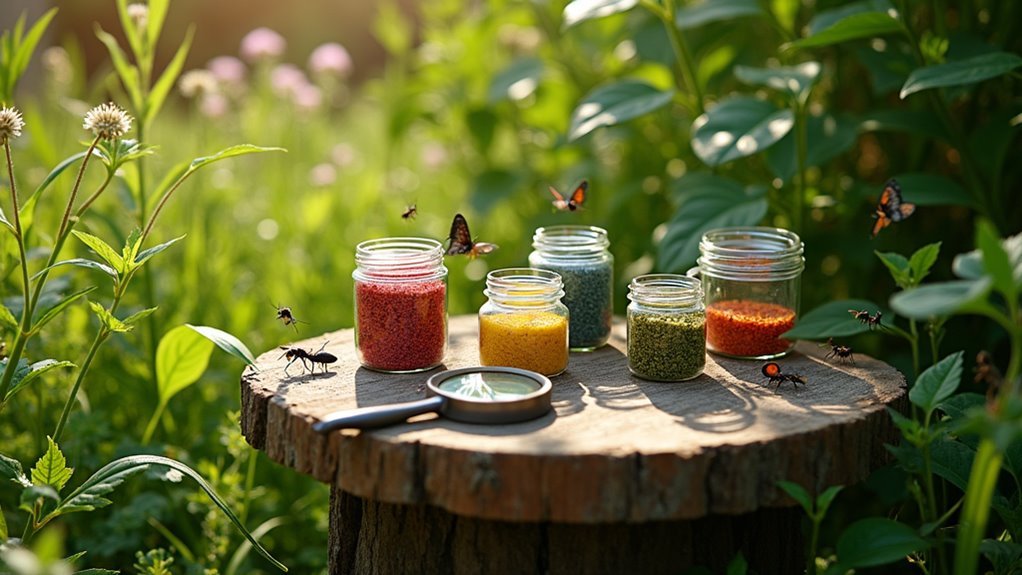You can naturally repel fleas from your yard by planting aromatic herbs and flowers that contain compounds these pests find repulsive. Mint, catnip, rosemary, and chrysanthemums are excellent choices that create protective barriers around your home. Most flea-repelling plants require full sun exposure and well-drained soil to thrive effectively. Strategic placement near foundations, entry points, and pet activity areas maximizes their deterrent properties while avoiding harmful chemical pesticides. Discover ideal growing conditions and placement strategies below.
Why Fleas Target Your Outdoor Spaces

Although fleas might seem like indoor pests, they’re actually drawn to your outdoor spaces for specific environmental reasons. Your yard becomes a flea haven when it offers moisture, shade, and overgrown vegetation that create perfect breeding conditions.
Yards with moisture, shade, and overgrown vegetation create ideal breeding environments that transform your outdoor space into a flea sanctuary.
Tall grass, compost piles, and dead leaves provide the shelter and humidity fleas need to thrive. Stray animals and wildlife frequently introduce these pests to your property, establishing populations in areas they visit regularly.
Fleas flourish in warm and humid climates, preferring temperatures between 70-85°F with high moisture levels. Without well-maintained lawns and regular yard care, you’re fundamentally rolling out the red carpet for flea infestations.
Strategic planting can help repel insects naturally while maintaining your outdoor appeal.
Top Flea-Repelling Plants for Natural Pest Control
Several common garden plants pack powerful flea-fighting properties that’ll transform your yard into a natural pest barrier.
Mint grows rapidly as an effective flea repellent, thriving in well-drained soil with six hours of daily sunlight.
Catnip’s nepetalactone compound deters fleas and mosquitoes while reaching three feet tall, requiring minimal watering.
Rosemary serves double duty, enhancing your cooking while repelling fleas and ticks in warm, dry conditions with 6-8 hours of sun.
Chrysanthemums contain pyrethrins, a natural insecticide that fights fleas effectively, though they need frequent watering and well-drained soil.
Lemongrass creates an attractive border plant with its citrus scent that fleas despise, flourishing in full sun across USDA zones 9-11.
These plants that repel fleas offer excellent natural pest control solutions.
Essential Growing Conditions for Flea-Deterrent Plants

You’ll need to understand specific growing conditions to successfully cultivate flea-repelling plants in your yard.
Most of these natural pest deterrents require full sun exposure and well-draining soil, though their watering needs vary greatly between species.
Your success depends on matching each plant’s requirements to your local climate zone and environmental conditions.
Sunlight and Soil Requirements
Success with flea-repelling plants hinges on providing proper sunlight and soil requirements that maximize their natural pest-deterrent properties. Most flea-deterrent plants thrive in full sun, needing at least six hours of direct sunlight daily for peak effectiveness.
Well-drained soil is vital for preventing overwatering and promoting healthy growth. Mint and catnip prefer loamy or sandy, well-drained conditions, while rosemary and sage flourish in warm, dry environments with sandy soil—perfect for coastal areas.
Marigolds and chrysanthemums require moderately fertile soil with regular watering to enhance their pest-repelling abilities. For warm-climate plants like citronella and lemongrass, you’ll want moist roots and spring planting after the last frost to guarantee successful establishment and maximum flea-deterrent effectiveness.
Watering and Drainage Needs
While proper sunlight sets the foundation for healthy flea-repelling plants, mastering their watering and drainage requirements guarantees they’ll reach their full pest-deterrent potential.
Most flea-deterrent plants like mint and basil need well-drained soil with medium to high watering to maintain proper moisture levels without waterlogging.
Rosemary and citronella grass prefer minimal watering and sandy, well-drained soil to prevent root rot.
Catnip and marigolds tolerate drought conditions while still requiring good drainage.
Chrysanthemums and pennyroyal need frequent watering for healthy growth due to their shallow root systems.
Regardless of plant type, you must ascertain adequate drainage throughout your garden—stagnant water creates ideal flea breeding conditions, defeating your pest-control efforts entirely.
Climate Zone Considerations
Understanding your local USDA hardiness zones determines which flea-repelling plants will thrive in your yard year-round versus those requiring seasonal replanting.
Mint and catnip flourish in zones 3-9, while rosemary prefers warmer zones 8-10. If you’re in zones 9-11, citronella and lemongrass excel with full sun exposure.
Many flea-repellent plants, including lavender and chrysanthemum, demand well-drained soil and 5-8 hours of daily sunlight.
Common rue and wormwood offer versatility across zones 4-10, adapting to various climates and soil conditions.
These plants that repel ticks and fleas each have unique temperature, moisture, and sunlight requirements.
Research your specific zone’s conditions before selecting varieties to verify successful establishment and peak pest-deterrent effectiveness in your landscape.
Strategic Placement Around Your Property

You can’t simply scatter flea-repelling plants randomly across your yard and expect maximum effectiveness.
Strategic placement around foundation perimeters, pet hangout zones, and high-traffic areas like porches creates targeted barriers where fleas are most likely to enter your home or establish themselves.
Focus your planting efforts on these three critical zones to build a thorough defense system that protects both your family and pets.
Foundation and Entry Points
Since fleas typically enter your property through gaps around your home’s foundation and doorways, creating a strategic barrier of repelling plants in these areas offers your first line of defense.
Focus on planting rosemary and mint directly around your foundation to establish this protective perimeter. You’ll want to position citronella and marigolds near entry points like doors, windows, and outdoor seating areas where foot traffic might carry fleas inside.
Chrysanthemums work exceptionally well along your home’s perimeter since they contain natural pyrethrins that repel fleas effectively.
When planning your landscape, space these flea-repelling plants approximately two to three feet apart to create continuous coverage. This targeted placement not only maximizes their pest-deterrent properties but also prevents gaps where fleas could slip through undetected.
Pet Activity Areas
While your foundation creates the first defensive barrier, your pets’ favorite outdoor spots require equal attention for thorough flea protection.
Transform areas where your furry friends spend time by strategically placing flea-repelling plants around pet activity areas. Rosemary and catnip work exceptionally well near relaxation zones, while mint and marigolds thrive under trees and around dog runs. Their potent essential oils create natural barriers that effectively repel fleas.
Consider adding lemongrass and basil to enhance both protection and visual appeal in these spaces. You’ll need to maintain consistent watering schedules to keep these plants flourishing.
Focus on perimeter placement around pet zones to discourage flea populations from establishing themselves. This strategic approach guarantees your pets stay comfortable while enjoying their favorite outdoor territories.
Porches and Patios
Beyond pet zones, porches and patios serve as critical passage areas where fleas often attempt to infiltrate your home’s interior spaces.
You’ll want to create natural barriers by planting mint and catnip around these entryways, which effectively repels fleas while providing pleasant aromas.
Strategically position rosemary and citronella near outdoor seating areas to keep fleas away and enhance your comfort outdoors.
Potted marigolds and basil offer dual benefits—they’re vibrant decorative elements that double as powerful insect repellent solutions.
These flea-repelling plants require 5-8 hours of daily sunlight to maximize their pest-deterring properties.
You’ll need to maintain regular watering and trimming schedules, as healthy plant growth directly correlates with their effectiveness in repelling fleas from your porches and patios.
Pet-Safe vs. Toxic Plant Options
When planning your flea-repelling garden, you’ll need to distinguish between plants that keep your pets safe and those that could harm them.
Pet-safe options like basil, catnip, mint, and rosemary effectively repel fleas while offering culinary benefits for your kitchen. These non-toxic options won’t cause adverse reactions if your pets brush against them or nibble the foliage.
Pet-safe herbs like basil, catnip, mint, and rosemary naturally repel fleas without harming curious pets who might taste the leaves.
However, toxic plants such as citronella and chrysanthemums contain compounds that can cause vomiting and skin irritation in pets, despite their flea-repelling properties. You should avoid these varieties in areas where your pets spend time.
Always research plant safety thoroughly and consult your veterinarian before selecting flea-repelling flora, especially if your pets tend to chew on plants.
Seasonal Care and Maintenance Tips
Selecting the right flea-repelling plants is only half the battle—maintaining them properly throughout the year guarantees they’ll continue protecting your yard from these persistent pests. Water flea-repelling plants like mint and rosemary appropriately, avoiding overwatering that causes root rot. Regularly mow your lawn to 2-3 inches, eliminating shaded breeding areas where ticks and fleas thrive. Trim overgrown shrubs to increase sunlight penetration and reduce humid environments. Apply beneficial nematodes during spring or fall to target larvae in soil naturally.
| Season | Primary Tasks | Timing |
|---|---|---|
| Spring | Apply beneficial nematodes, plant new herbs | Early season |
| Summer | Regular mowing, proper watering schedule | Weekly maintenance |
| Fall | Debris cleanup, nematode reapplication | Before winter |
Maximizing Effectiveness With Companion Planting
While individual flea-repelling plants provide solid protection, you’ll amplify their effectiveness by strategically combining them through companion planting.
Create natural barriers by pairing rosemary and mint around vulnerable areas—their strong scents work together to keep fleas away while supporting each other’s growth.
Strategic pairing of rosemary and mint creates powerful natural barriers, combining their aromatic defenses to effectively repel fleas from vulnerable garden areas.
Plant marigolds alongside your vegetables to add vibrant color while this combination repels insects and reduces chemical pesticide needs.
Position catnip near pet areas to attract beneficial insects while deterring fleas.
You’ll enhance pest control by combining lavender and basil, as their aromatic properties work synergistically to mask scents that attract pests.
Place lemongrass and citronella in sunny spots near shaded areas where these flea-repelling plants thrive in conditions unfavorable for fleas, maximizing your garden’s protective coverage.
Frequently Asked Questions
What Plant Keeps Fleas Out of Your Yard?
You can plant catnip, rosemary, lemongrass, mint, or chrysanthemums to keep fleas out of your yard. These plants naturally repel fleas through their scents and compounds while thriving in sunny, well-drained soil conditions.
What Is the One Thing That Fleas Hate?
You’ll find that fleas absolutely hate strong scents, particularly mint’s powerful aroma. This intense fragrance overwhelms their sensitive systems, making mint one of the most effective natural deterrents you can use against these persistent pests.
What Is the Fastest Way to Get Rid of Fleas in the Yard?
You’ll get fastest results by applying beneficial nematodes to target flea larvae while simultaneously mowing your lawn short to expose fleas to sunlight they hate, eliminating multiple life stages quickly.
What Smell Do Fleas Hate the Most?
You’ll find fleas hate mint, lavender, and rosemary scents the most. These plants contain natural compounds that irritate their sensory organs. Citronella, catnip’s nepetalactone, and basil’s essential oils also effectively repel them.
In Summary
You’ve got the tools to create a natural flea barrier around your home. Plant these flea-repelling varieties in strategic locations, guarantee they’re getting proper growing conditions, and you’ll see results. Remember to choose pet-safe options if you’ve got furry friends, and don’t forget about companion planting for maximum effectiveness. With consistent seasonal care, you’ll maintain a beautiful yard that keeps fleas at bay naturally.





Leave a Reply